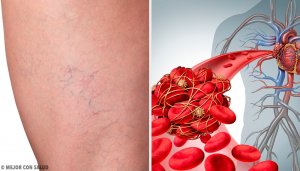The 3 Best Home Remedies for Phlebitis


Reviewed and approved by Doctor Carlos Fabián Avila
Phlebitis is a circulatory disorder that occurs when the blood vessels become inflamed. This primarily affects varicose veins. According to a study carried out at the Santiago Military Hospital, phlebitis can be infectious or non-infectious, depending on the individual case.
In some cases, the area can worsen and blood clots form on the walls of the veins, causing what is known as thrombophlebitis. The areas that it mainly affects are the arms, legs and shoulders.
This alteration of the blood vessels can affect people of any age. Furthermore, it’s often asymptomatic and thus, dangerous. This is because you wouldn’t know about it until it the more serious symptoms of thrombophlebitis. As you can see, it’s important to prevent it and ensure early diagnosis.

Types of phlebitis
Depending on the level of severity, phlebitis is classified as:
- Superficial: the damage is under the skin and mainly affects the veins. There’s a low risk of blood clotting. However, it can pose a significant danger, depending on the individual patient.
- Deep: this occurs in the muscles and tissues. In this case, the quantity of blood is much greater, so there is more pressure on the blood clots. What’s concerning is that these might break off and travel towards the heart, blocking the arteries. For this reason, deep phlebitis comes with complications such as embolisms. These require immediate medical attention.
Causes of phlebitis
There are many reasons why someone may develop phlebitis. Not all cases are the same, however, and some people are more prone to it than others. Some common causes include:
- Pregnancy: as confirmed by this investigation carried out by Hospital Provincial Docente Clinicoquirúrgico “Saturnino Lora Torres” of Santiago de Cuba.
- Cancer: according to this report from The Sociedad Española de Oncología Médica.
- Venous insufficiency.
- Alterations in blood circulation.
- Trauma and burns.
- Bacterial infections: as concluded by this study by Hospital Clínico Universitario of Valladolid.
Read this Description of Phlebitis and Its Symptoms and Treatment
Symptoms
It’s worth mentioning that phlebitis sometimes goes unnoticed and is often discovered accidentally. However, it’s important to keep a look-out, as some general symptoms can help you to receive an early diagnosis, and avoid any serious complications.
Furthermore, some of the most common symptoms include:
- Constant pain in area of the affected vein
- Extreme sensitivity
- The area is warmer than it should be
- Accelerated heart rate
- Fever, which occurs in cases of infectious phlebitis, according to this study conducted by Revista Chilena de Infectologíaisease
Natural remedies for phlebitis
Natural remedies for phlebitis can be useful for reducing some of the most common symptoms of this condition. In fact, some have properties that can significantly improve blood flow.
However, it’s important to be aware that these remedies are no miracle cure, and they’re not 100 percent safe. As such, they’re no substitute for medical treatment. Thus, consult your doctor before trying them as they could cause side effects or interact with prescribed drugs.
In this next section, we’ll explain the properties of these natural remedies. You’re to use them only to complement any treatment prescribed by your doctor.
1. Cranberries are one of the remedies for phlebitis

This small fruit contains an immense quantity of nutrients. In addition, it contains flavonoids, vasodilators that can help to improve blood flow.
Cranberries also have certain anti-inflammatory properties, as confirmed by this study by Universidad de Barcelona. This citrus can reduce swelling, pain and redness
Read more about The Health Properties of Cranberry Juice
2. Apply heat and cold
This technique is as simple as alternating the temperatures with the purpose of reducing the inflammation, relaxing the muscles and calming the pain. Thus, simply alternate between a hot water compress and a cold water compress, applying each to the affected area for 10 minutes. According to this study by Universidad de Las Americas in Chile , the cold can act as a sedative or analgesic.
3. Arnica is one of the common remedies for phlebitis

Arnica is one of the best natural painkillers, as confirmed by this investigation by Hospital Pedro Betancourt in Matanzas, Cuba.
You can use arnica as an ointment, an oil, a cream or take it as a tea.
Recommendations
As well as using the remedies outlined above, the following tips could help relieve symptoms of phlebitis:
- Firstly, move your arms and legs at least every two hours.
- At the end of each day, lie down and elevate your legs, leaning your heels against the wall to get the blood flowing. There’s no scientific evidence to support the benefits of this practice but it’s a simple remedy you can do.
- Also, walk barefoot for a few minutes every day to help strengthen bones and muscles.
- Furthermore, be physically active — at least three times a week.
- Avoid tobacco, as it can damage your circulation, as confirmed by this study published in Revista Uruguaya de Cardiología.
- Don’t ignore your symptoms. If you suddenly have swelling or pain for no apparent reason, go for a check-up.
- Finally, try to sleep with your legs raised on a pillow.
Remember that the information and remedies mentioned above are only a guide. It’s crucial to seek the opinion of a specialist when it comes to circulatory problems.
All cited sources were thoroughly reviewed by our team to ensure their quality, reliability, currency, and validity. The bibliography of this article was considered reliable and of academic or scientific accuracy.
- Zoraya Rojas-Sánchez, L., Parra, D. I., & Camargo-Figuera, F. A. (2015). Factores asociados al desarrollo de flebitis: resultados del estudio piloto de una cohorte. Abstract Resumo. https://doi.org/10.12707/RIII13141
- Velázquez-Mendoza, S., Gómez-Alonso, C., Cuamatzi-Peña, M. T., Izquierdo-Puente, M. I., & Neonatos, @bullet. (2009). Conocimiento y criterios de enfermería para evitar flebitis en neonatos con catéter venoso periférico Palabras clave. Rev Enferm Inst Mex Seguro Soc.
- Arias-Fernández, L., Suérez-Mier, B., Martínez-Ortega, M. del C., & Lana, A. (2017). Incidencia y factores de riesgo de flebitis asociadas a catéteres venosos periféricos. Enfermeria Clinica. https://doi.org/10.1016/j.enfcli.2016.07.008
This text is provided for informational purposes only and does not replace consultation with a professional. If in doubt, consult your specialist.








